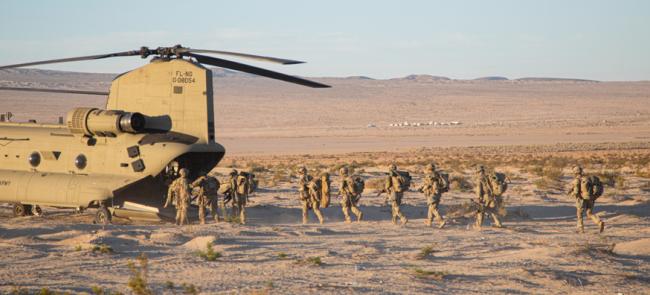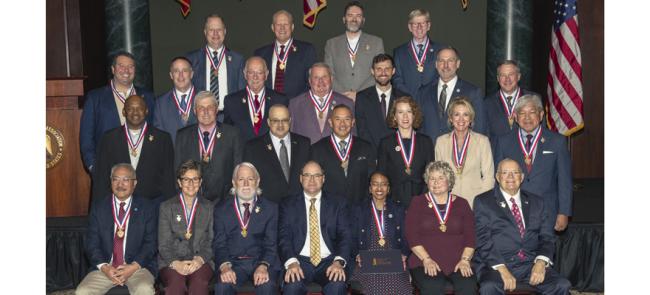
Parting Thoughts
I always enjoy writing this annual report to our members. It’s an opportunity to compile and share with a large audience what we have accomplished together over the last 12 months.
Once again, we have much to talk about. This year, however, I will also reach back and offer some highlights from my seven very rewarding years at the association. I also want to share what I’ve learned about the National Guard and things in our nation’s capital while I’ve been NGAUS president, a position I will have handed over to retired Maj. Gen. Francis M. McGinn, of Massachusetts, by the time you read this.
First, I’m pleased to report significant growth in our ranks last year, nearly 1,200 active members. The increase was spread across the country. Forty-five states or territories saw their membership totals rise (Membership chart). And this was after we added nearly 1,000 members in 2022.
Here’s why membership tops my list of 2023 accomplishments: Members of Congress understand numbers. They count votes to gain and stay in office. They notice when an organization asking for their support has the backing of a growing membership.
With more members, we are a more influential organization. It impacts all that we do. So, thank you to the men and women who joined for the first time and to those who chose to remain part of NGAUS. My appreciation also goes out to the state and territory executive directors who work hard to ensure Guard officers know what our association is doing on their behalf.
And in 2023, we did a lot, the results of which we have not yet fully realized.
Most of you have seen or heard the stories: Congress is having a hard time getting things done. Not only did partisan differences get in the way, so did intraparty squabbles. The result is, four months into fiscal 2024, we still don’t have a budget for this year, and we won’t until at least March.
By now, I can usually share our equipment successes for the Guard in defense appropriations. Last year, the total was $7 billion, including more than $4 billion lawmakers added to the president’s fiscal 2023 budget request at our prompting. Money is tighter for fiscal 2024, but I’m confident we’ll have similar success for fiscal 2024.
We did score some policy victories in the fiscal 2024 National Defense Authorization Act, which the president signed in December.
One is the elevation of the National Guard Bureau vice chief from three to four stars. It will put the position on the same level as the other vice chiefs in the Pentagon. The current rank places NGB at a disadvantage in some meetings, like those involving the Joint Requirements Oversight Council.
Another provision will provide all birth mothers, spouses, partners and adoptive and foster parents with three months of excused absences from drill with retirement points. Currently, under the Reserve Component Maternity Leave Program, only birth mothers are eligible for this benefit.
It’s part of our continuing effort to give Guardsmen and their families benefits parity with the active component. Active-duty birth mothers, spouses, partners and adoptive and foster parents are eligible for 12 weeks of maternity leave.
Additionally, the 2024 NDAA will require the secretary of the Air Force to develop a long-term tactical fighter force structure, recapitalization, training and sustainment plan for the active and reserve components of the Air Force.
The provision is progress, but we still have Guard units that don’t have aircraft identified to replace the fighters the Air Force plans to retire starting next year. If these units aren’t provided follow-on fighter missions, the nation will lose some of its most experienced pilots and maintainers at a time when we are struggling to attract such talent.
Back at the National Guard Memorial, the NGAUS headquarters in Washington, D.C., we made some changes to some major association programs.
New York Life is now the insurance carrier for the NGAUS Insurance Trust’s exclusive Technician Disability Income Insurance program. NGAUSIT now provides 12 months of no-cost coverage for all newly hired Guard technicians and Title 5 employees.
The National Guard Educational Foundation’s Guardian Scholarship also has a new underwriter, USAA. The program awards college scholarships of up to $6,250 a year to the children of Guardsmen killed in the Global War on Terror.
There were nine scholarship recipients for the 2023-2024 academic year. One was Gabriela Bowen, who was just three years old when her father, Maryland Army Guard Sgt. 1st Class Collin Bowen, died from wounds he suffered in Afghanistan in 2008.
NGAUS and the NGEF have many great programs, but none are more personally satisfying than the Guardian Scholarship.
I'm very proud of the progress we've made in accelerating modernization.
More Equipment
Among my highest priorities has been winning congressional support to accelerate Guard equipment modernization and bringing our soldiers and airmen closer to benefits parity with the active component.
Together, I think we made some real progress on both fronts (Top 10 List, below).
Equipment modernization is imperative, and it’s even more critical in today’s world than it was when I arrived in 2017. The Guard plays a vital role in the current National Defense Strategy, but it’s not always reflected in our place in service plans for new systems.
Two glaring examples are C-130J Super Hercules cargo planes and MQ-1C Gray Eagle unmanned aerial systems.
Active-component Air Force C-130 units fly only the latest variant of the venerable intratheater cargo plane; however, the service has never included one for the Guard in a presidential budget request. The situation is similar with Gray Eagles: Active-component Army divisions have had them for years. Service leaders consider them critical to pinpointing long-range fires, but they’ve never requested one for any the Guard’s eight combat divisions.
Enter NGAUS. We asked Congress for help and lawmakers added funds to fiscal 2023 defense appropriations to purchase 16 C-130Js and 12 Gray Eagles for the Guard. The more than $4 billion added last year for Guard equipment also included new tanks, howitzers, helicopters, rebuilt Humvees and upgrades for F-16 Fighting Falcons and C-130Hs.
The 16 C-130Js bring to 58 the number of new cargo planes Congress has added at our urging. This is enabling the Guard to recapitalize much, but not all, of our C-130 fleet. The Gray Eagles are the Guard’s first, and they are just enough to outfit one division.
Convincing Congress to add funds for Guard equipment has become a routine part of our work on Capitol Hill, but even some equipment included in recent budget requests is a product of conversations we’ve had over the years with service officials.
Our work is far from done here, but I’m very proud of the progress we’ve made in accelerating modernization. The effort involved far more than the NGAUS staff. Our task forces of volunteer subject-matter experts, the adjutants general and others made major contributions.
Advances in benefits parity have required the same persistence we employed on equipment. Take, for example, our effort to fix the flaws in mobilization authority 12304b. It took four years, but we got it done.
Congress created this new authority in 2012 to give the services easier access to the Guard and Reserve. But it lacked the personnel benefits provided by other authorities, including premobilization and transitional health care and credit toward the GI Bill and early retirement pay. Change didn’t occur quickly, but it did come.
In the summer of 2017, the Forever GI Bill included 12304b. A few months later, the fiscal 2018 NDAA provided premobilization and transitional health care to those on the new mobilization authority. And the fiscal 2020 NDAA included a provision that provided credit toward early retirement pay for those mobilized under the new authority.
Incentive-pay parity is another recent victory. It’s now the law, according to the fiscal 2022 NDAA. NGAUS helped write the language, but the Pentagon has yet to implement it.
Guardsmen and Reservists get only a fraction of the incentive pay that active-duty troops receive, despite having to maintain the same proficiency. Unfortunately, language added late in the legislative process gave the Defense Department until Sept. 30, 2022, to certify to Congress the change wouldn’t adversely affect any component. Officials have yet to formally respond.
We also worked successfully with Capitol Hill to provide some future relief to Guard officers waiting for federal recognition of their state promotions. A provision in the fiscal 2023 NDAA requires the appropriate service secretary to backdate the effective date of rank for any Guard officer waiting more than 100 days for their FEDREC after Jan. 1 of this year.
I’m disappointed we didn’t get further on health care. Making medical coverage available to every Guard soldier and airmen is not a matter of benefits parity, it’s about readiness.
We provide medical coverage to every member of the active component so they can be immediately ready when the nation calls. We ask no less from Guard soldiers and airmen, yet we offer them little in the way of preventative care. And we cover them only when they are on federal orders of more than 30 days.
I’ve mentioned this in my travels to many people outside the military. Most are shocked to learn the nation doesn’t cover everyone who wears the cloth of our country. Many have asked me why not. Cost is the reason we hear from some in Congress.
But zero-cost TRICARE would add only about 1% to the nearly $60 billion the military spends annually on health care. And it would pay for itself in higher readiness and retention and the elimination of what the Guard now pays annually for troop physicals by medical contractors.
Lawmakers need to fix this. It’s long overdue.
With more members, we are a more influential organization.
Lean Into the Friction
I am frequently asked what I learned during my time in Washington. Most of the questions come from friends and colleagues who know I spent my days in uniform in Mississippi-based units. Frankly, I actively avoided coming here for many years.
One thing that stood out quickly was how little most people know about the Guard once you leave your unit and the surrounding community.
I mentioned earlier my conversations with people, including reporters, about the Guard and the lack of medical coverage. Most Americans also have little knowledge of the full range of responsibilities we have in our states and to the nation. They also don’t know our history, especially our roots in the Constitution. It’s a product of not many people having contact with members of our force.
This points to the need for more people to hear our story. And the responsibility to tell our story falls on us — not just NGAUS, but every current and former member of the Guard, every retired member and even family members when possible. It’s important to both the Guard and the nation.
Senior defense leaders also need to hear our story. Many simply don’t know what we need and what we can bring to the fight if properly resourced. And there is a severe lack of understanding when it comes to the Guard’s responsibilities to our states and territories. We don’t belong to the federal government until we are mobilized by the president. It’s a foreign concept to them.
There is natural friction here between the governors and the president, between Guard leaders and the Pentagon. We can only serve one chain of command at a time. Some people think the friction is bad, that it gets in the way. It’s just the opposite. It’s by design, and when it works the way our forefathers intended, it compels some deep, intense discussions before we commit our soldiers and airmen to war.
I didn’t fully appreciate the friction until I arrived. I also didn’t fully realize how vital it is for us to lay out our own destiny as a force and work toward it. If we had just sat quietly over the years and let the Army and Air Force dictate our posture and structure, we wouldn’t be the force we are today. We need to stay involved even if we have to push our way in. And we must lean into the friction.
One thing my seven years has reinforced is that the Guard is a family. One very big family with every gender, race, ethnicity, religion, accent and political belief this melting pot of a nation has to offer. Everywhere my wife, Susan, and I visited, we were treated like we were part of the local organization, like part of their family.
Your friendship is something I will never forget. It’s been the privilege of my life to serve our association.
Retired Brig. Gen. J. Roy Robinson can be reached via [email protected].
Top 10 NGAUS Legislative Victories Since 2017
1. More than $41 billion for Army and Air Guard equipment, military construction and counterdrug operations in annual defense appropriations from fiscal 2018 to 2023; $7 billion expected in 2024
2. Benefits parity for mobilizations under 12304b orders (fiscal 2018 & 2020 NDAA) 3. Incentive and special-pay parity (implementation pending) (fiscal 2022 NDAA)
4. Three-month maternity leave from drill with retirement credit and pay (fiscal 2021 NDAA)
5. Required backdating of the effective date of rank of National Guard officers waiting more than 100 days for federal recognition of their state promotions (fiscal 2023 NDAA)
6. Credit for Title 32 service toward VA home loans (fiscal 2021 NDAA)
7. Creation of a federally recognized service document (DD-214-1) for all Guardsmen upon completion of service (2022 DoD policy memo)
8. Access to TRICARE Reserve Select for full-time federal employees who serve in the Guard and Reserve, including dual-status technicians, beginning in 2030 (fiscal 2020 NDAA)
9. Expanded federal employment protections for those on state active duty (fiscal 2021 NDAA)
10. National Guard Bureau chief authorized to submit to Congress an unfunded priorities list of disaster-response items (fiscal 2023 NDAA)



